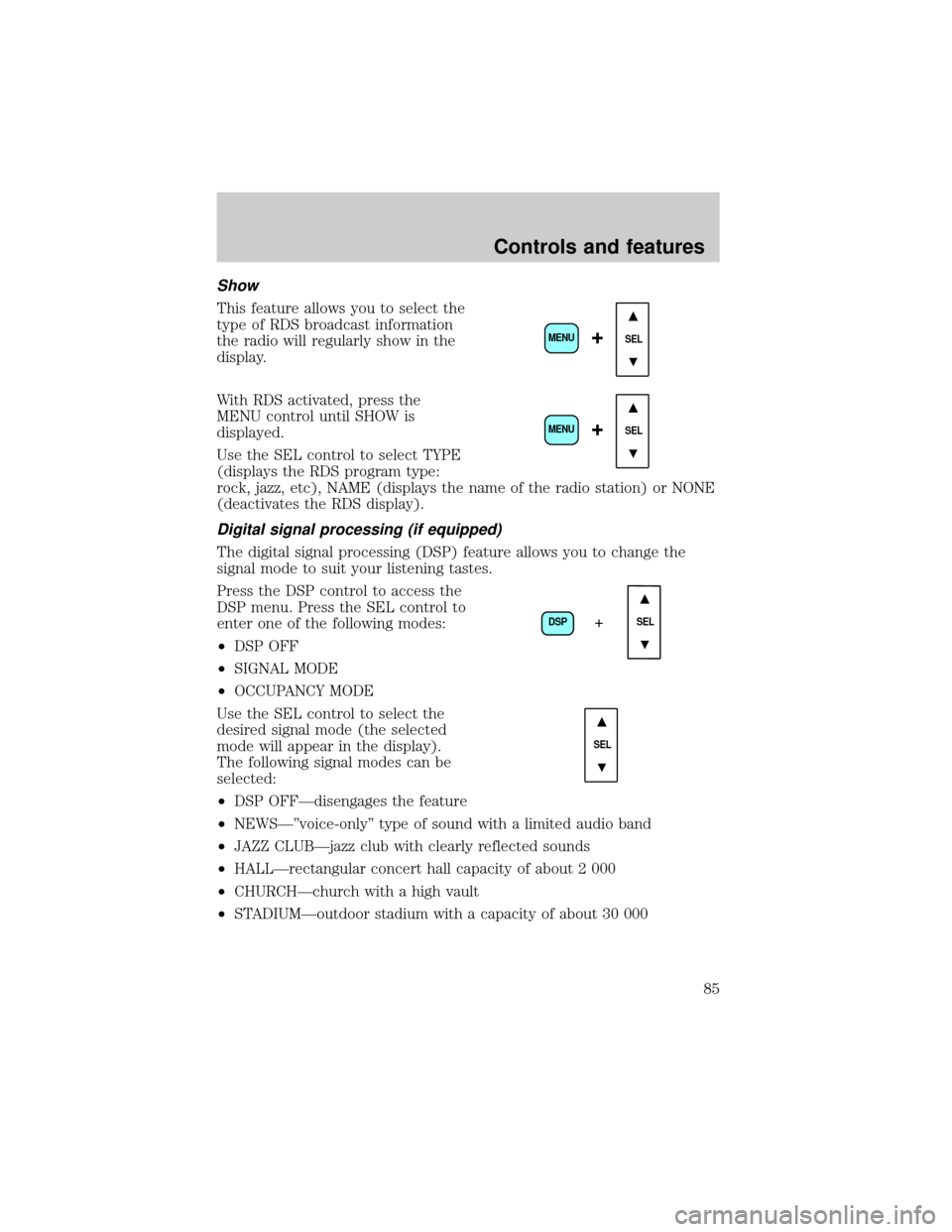Page 85 of 312

Show
This feature allows you to select the
type of RDS broadcast information
the radio will regularly show in the
display.
With RDS activated, press the
MENU control until SHOW is
displayed.
Use the SEL control to select TYPE
(displays the RDS program type:
rock, jazz, etc), NAME (displays the name of the radio station) or NONE
(deactivates the RDS display).
Digital signal processing (if equipped)
The digital signal processing (DSP) feature allows you to change the
signal mode to suit your listening tastes.
Press the DSP control to access the
DSP menu. Press the SEL control to
enter one of the following modes:
²DSP OFF
²SIGNAL MODE
²OCCUPANCY MODE
Use the SEL control to select the
desired signal mode (the selected
mode will appear in the display).
The following signal modes can be
selected:
²DSP OFFÐdisengages the feature
²NEWSкvoice-onlyº type of sound with a limited audio band
²JAZZ CLUBÐjazz club with clearly reflected sounds
²HALLÐrectangular concert hall capacity of about 2 000
²CHURCHÐchurch with a high vault
²STADIUMÐoutdoor stadium with a capacity of about 30 000
SEL+MENU
SEL
+MENU
DSP
SEL+
SEL
Controls and features
85
Page 88 of 312

Radio frequency information
The Federal Communications Commission (FCC) and the Canadian Radio
and Telecommunications Commission(CRTC) establish the frequencies
AM and FM stations may use for their broadcasts. Allowable frequencies
are:
AM 530, 540±1600, 1610 kHz
FM 87.7, 87.9±107.7, 107.9 MHz
Not all frequencies are used in a given area.
Radio reception factors
Three factors can affect radio reception:
²Distance/strength.The further an FM signal travels, the weaker it is.
The listenable range of the average FM station is approximately 40 km
(24 miles). This range can be affected by ªsignal modulation.º Signal
modulation is a process radio stations use to increase their
strength/volume relative to other stations.
²Terrain.Hills, mountains and tall buildings between your vehicle's
antenna and the radio station signal can cause FM reception problems.
Static can be caused on AM stations by power lines, electric fences,
traffic lights and thunderstorms. Moving away from an interfering
structure (out of its ªshadowº) returns your reception to normal.
²Station overload.Weak signals are sometimes captured by stronger
signals when you pass a broadcast tower. A stronger signal may
temporarily overtake a weaker signal and play while the weak station
frequency is displayed.
The audio system automatically switches to single channel reception if it
will improve the reception of a station normally received in stereo.
Audio system warranties and service
Refer to the ªWarranty Guideº for audio system warranty information.
If service is necessary, see your dealer or a qualified technician.
Controls and features
88
Page 99 of 312
STEERING WHEEL CONTROLS (IF EQUIPPED)
These controls allow you to operate some radio and climate control
features.
Audio control features
Press
to select AM, FM1, FM2,
TAPE, or CD (if equipped).
In AM, FM1, or FM2 mode:
²Press MEM to select preset
stations within the selected radio
band.
In Tape mode:
²Press MEM to select the next
selection on the tape.
In CD mode:
²Press MEM to select the next
selection on the CD.
In any mode:
²Press VOL + or þ to adjust
volume.
Controls and features
99
Page 304 of 312

A
Air bag supplemental
restraint system ................155, 159
and child safety seats ............157
description ......................155, 159
disposal ....................................162
driver air bag ..................157, 160
indicator light ...........10, 159, 161
operation .........................157, 160
passenger air bag ...........157, 160
side air bag ..............................159
Air cleaner filter .......................283
Air conditioning ..........................33
automatic temperature
control system ..........................37
auxiliary heater and air
conditioner ................................46
rear seat controls .....................47
Ambulance packages ....................3
Antifreeze
(see Engine coolant) ................241
Anti-lock brake system
(see Brakes) ......................176±177
Anti-theft system ......................125
arming the system ..................125
disarming a
triggered system .....................126
warning light .............................11
Audio system (see Radio) ...51, 74
Automatic transmission
driving an automatic
overdrive .................................182
fluid, adding ............................248
fluid, checking ........................248
fluid, refill capacities ..............283
fluid, specification ..................287
Auxiliary power point ...............112Axle
lubricant specifications ..285, 287
refill capacities ........................283
traction lok ..............................194
B
Battery .......................................251
acid, treating emergencies .....251
charging system
warning light .............................11
jumping a disabled battery ....222
maintenance-free ....................251
replacement, specifications ...283
servicing ..................................251
voltage gauge ............................16
Belt minder ...............................151
Brakes ........................................176
anti-lock ...........................176±177
anti-lock brake system
(ABS) warning light .........11, 177
brake warning light ..................10
fluid, checking and adding ....240
fluid, refill capacities ..............283
fluid, specifications .........285, 287
lubricant specifications ..285, 287
parking ....................................177
pedals (see Power
adjustable foot pedals) ............30
shift interlock ..........................180
Break-in period .............................3
C
Capacities for refilling fluids ....283
Cargo cover ...............................115
Certification Label ....................289
Child safety restraints ..............162
child safety belts ....................162
Index
304
Page:
< prev 1-8 9-16 17-24